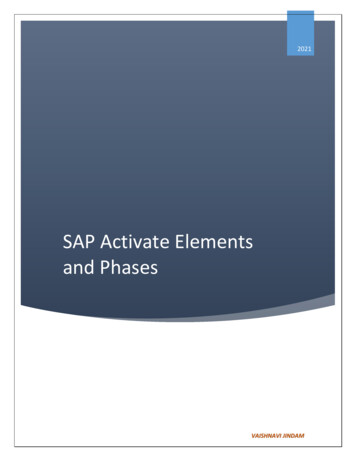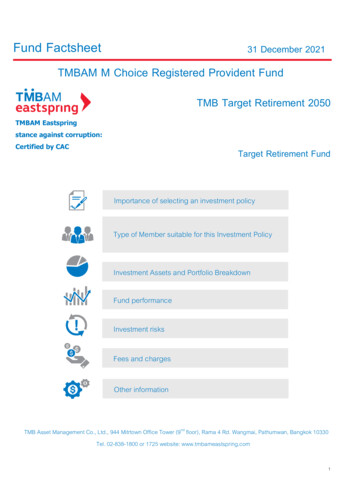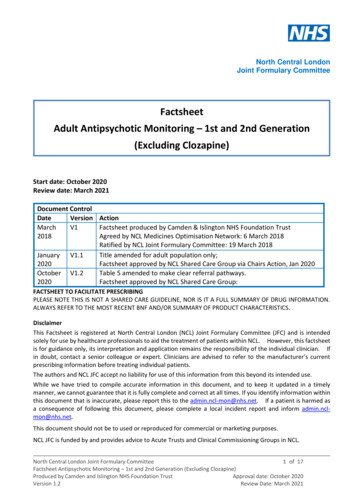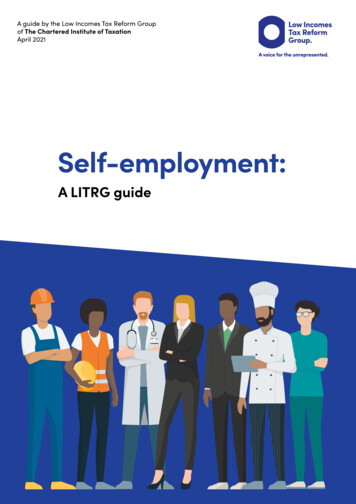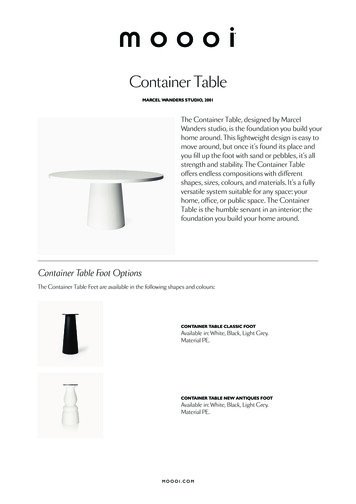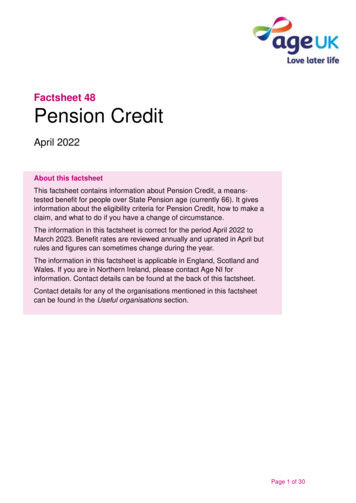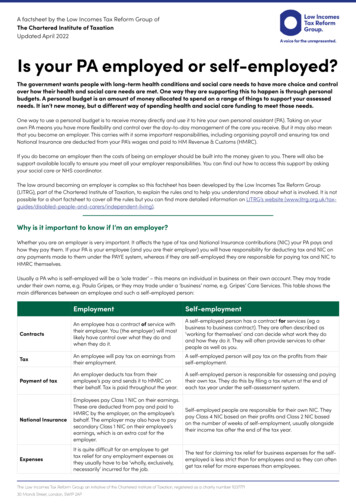
Transcription
A factsheet by the Low Incomes Tax Reform Group ofThe Chartered Institute of TaxationUpdated April 2022Is your PA employed or self-employed?The government wants people with long-term health conditions and social care needs to have more choice and controlover how their health and social care needs are met. One way they are supporting this to happen is through personalbudgets. A personal budget is an amount of money allocated to spend on a range of things to support your assessedneeds. It isn’t new money, but a different way of spending health and social care funding to meet those needs.One way to use a personal budget is to receive money directly and use it to hire your own personal assistant (PA). Taking on yourown PA means you have more flexibility and control over the day-to-day management of the care you receive. But it may also meanthat you become an employer. This carries with it some important responsibilities, including organising payroll and ensuring tax andNational Insurance are deducted from your PA’s wages and paid to HM Revenue & Customs (HMRC).If you do become an employer then the costs of being an employer should be built into the money given to you. There will also besupport available locally to ensure you meet all your employer responsibilities. You can find out how to access this support by askingyour social care or NHS coordinator.The law around becoming an employer is complex so this factsheet has been developed by the Low Incomes Tax Reform Group(LITRG), part of the Chartered Institute of Taxation, to explain the rules and to help you understand more about what is involved. It is notpossible for a short factsheet to cover all the rules but you can find more detailed information on LITRG’s website rers/independent-living).Why is it important to know if I’m an employer?Whether you are an employer is very important. It affects the type of tax and National Insurance contributions (NIC) your PA pays andhow they pay them. If your PA is your employee (and you are their employer) you will have responsibility for deducting tax and NIC onany payments made to them under the PAYE system, whereas if they are self-employed they are responsible for paying tax and NIC toHMRC themselves.Usually a PA who is self-employed will be a ‘sole trader’ – this means an individual in business on their own account. They may tradeunder their own name, e.g. Paula Gripes, or they may trade under a ‘business’ name, e.g. Gripes’ Care Services. This table shows themain differences between an employee and such a self-employed person:EmploymentSelf-employmentContractsAn employee has a contract of service withtheir employer. You (the employer) will mostlikely have control over what they do andwhen they do it.A self-employed person has a contract for services (eg abusiness to business contract). They are often described as‘working for themselves’ and can decide what work they doand how they do it. They will often provide services to otherpeople as well as you.TaxAn employee will pay tax on earnings fromtheir employment.A self-employed person will pay tax on the profits from theirself-employment.Payment of taxAn employer deducts tax from theiremployee’s pay and sends it to HMRC ontheir behalf. Tax is paid throughout the year.A self-employed person is responsible for assessing and payingtheir own tax. They do this by filing a tax return at the end ofeach tax year under the self-assessment system.National InsuranceEmployees pay Class 1 NIC on their earnings.These are deducted from pay and paid toHMRC by the employer, on the employee’sbehalf. The employer may also have to paysecondary Class 1 NIC on their employee’searnings, which is an extra cost for theemployer.Self-employed people are responsible for their own NIC. Theypay Class 4 NIC based on their profits and Class 2 NIC basedon the number of weeks of self-employment, usually alongsidetheir income tax after the end of the tax year.ExpensesIt is quite difficult for an employee to gettax relief for any employment expenses asthey usually have to be ‘wholly, exclusively,necessarily’ incurred for the job.The test for claiming tax relief for business expenses for the selfemployed is less strict than for employees and so they can oftenget tax relief for more expenses than employees.The Low Incomes Tax Reform Group an initiative of the Chartered Institute of Taxation, registered as a charity number 10377711 30 Monck Street, London, SW1P 2AP
Is your PA employed or self-employed?ContinuedWho decides if my PA is employed or self-employed?It is very important to understand that it is your responsibility to correctly decide the ‘status’ of your PA (that is, whether they areemployed or, less commonly, self-employed) based on the specific working arrangements between you, so that you can operate PAYEif you need to.You cannot just pick a status because it is either better for you or because the PA wants to be self-employed or because the PA statesthey are self-employed for the work they do for others. Tax law can override what either you or your PA intended. This means that evenif you have a contract with your PA that says they are self-employed, if the facts indicate otherwise, HMRC can decide that they must betreated as your employee.You need to decide the status of any PA that works for you, including ones that you are matched with via an ‘introductory’ agency (evenif the agency calls them ‘self-employed’). The only time you do not need to worry about deciding the status of your PA is where theysupply their services through their own limited company or through an agency that they are both paid and ‘managed’ by – in thesecases, the responsibility for deciding their status lies elsewhere.Why have I not been told any of this before?You may have had a personal budget for some time and it may be the case that the law around becoming an employer was notdiscussed with you at all or you may have been told that you could engage your PA on a self-employed basis without properly checkingtheir status. This is not correct and if you have a ‘self-employed’ PA, it is vital that you check whether this status is correct, or whether theyare actually an employee.If they are an employee then you need to take immediate action. The most important thing is that you register as an employer withHMRC and start operating PAYE going forward. You then need to consider what action needs to be taken to put right the incorrecthistoric position. You should probably seek advice on this from a professional tax adviser and you should speak to your social care orNHS coordinator about arranging this.How do I decide if my PA is employed or self-employed?In most cases it is generally straightforward as to whether your PA is an employee or self-employed. The general rule is that your PA willbe: An employee if they work for you and do not have the risks of running a business. Self-employed if they run their own business on their own account and are responsible for the success or failure of that business.In deciding whether a PA is working for you or in business on his or her own account, a variety of factors are relevant. Some of the mostimportant ones in a care and support situation are outlined below:Mutuality of obligationWhere you are under an obligation to provide and pay for work and the individual is under a similar obligation toaccept the work and to perform the tasks delegated to them, this usually points to the relationship being one ofemployment. If an individual is self-employed, they will have no guarantee of work and even if work is offered to them,they are under no legal obligation to accept the work offered.Right of controlIf you can tell an individual what to do, how to do it and when to do it by, this will usually be seen as a strong pointerto employment. On the other hand, a self-employed individual will have far more control over the jobs that theyundertake and the deadline for completion of those jobs.Right of substitutionAn employee will have no freedom to send a substitute in his or her place if, for whatever reason, they are unable toperform their duties. On the other hand, if a self-employed individual has contracted to do a job and is either sick ordouble-booked, that self-employed person will usually have the unfettered (or unrestricted) freedom to provide asubstitute of their choosing to complete the job in his or her place.Provision of equipmentAn employee is rarely responsible for providing his or her own equipment. A self-employed individual, on the otherhand, will normally be responsible for providing the necessary equipment to enable them to undertake the workoffered. However this factor will only be relevant in helping to decide if someone is self-employed where the equipmentinvolved is significant. The provision of ‘small’ items like gloves or wipes will therefore not count.The Low Incomes Tax Reform Group an initiative of the Chartered Institute of Taxation, registered as a charity number 103777130 Monck Street, London, SW1P 2APUpdated April 20222
Is your PA employed or self-employed?ContinuedHow do I apply the rules?You will need to carefully consider each of the factors above, based on the relationship you have with your PA and weigh up thosepointing to employment against those pointing away from employment. Having done that, a picture will emerge from whichemployment status can usually be decided.If you have more than one PA, you will need to decide the status of each of them separately (and you should note it is perfectly possiblefor someone who does not work full-time to be an employee). Your PA may have another job in which they are self-employed or theymay have a ‘Unique Taxpayer Reference’ from having been self-employed previously, but all of this is irrelevant – you need to work outtheir status solely on the work they do for you now.In general, most PAs we come across are employees (unless they work through their own limited company or are paid and managedby an agency as set out in the box ‘Who decides if my PA is employed or self-employed?’). This is because the work of the PA is verymuch determined by the person they care for, which means that the PA may struggle to fall within some of the tests of self-employment.For example: Mutuality of obligation: You may rely on your PA to help you with day-to-day living, so they will probably work regular and set hoursand not have the ability to turn down work. Control: Given that care needs are usually very specific and you will have your own care plan, it is unlikely that a PA will have a greatdegree of control over what work is carried out and how. Indeed, they would be at risk of negligence if a care plan had been agreedand they deviated from it without prior agreement/good reason. Substitution: By virtue of the very personal nature of your relationship with your PA, it may not be appropriate for them to be able tosend someone else in their place. Provision of own equipment: This may well not be appropriate or necessary as you may have all the necessary equipment in yourown home for use, as it is likely that much will be in the form of adaptations fitted within the property – lifts/hoists, etc.What do HMRC say?HMRC’s guidance in relation to care provided in a client’s home, set out in the Employment Status manual -manual/esm4015), states the following: ‘The case law tests normally indicate that a careworker who looks after a client in the client’s home is likely to be an employee. In particular there will often be a significant rightof control, for example the carer required to arrive at a pre-arranged time and perform tasks at the request of the client. Onoccasions the facts may indicate self-employment. For example, it may be the case that a care worker looks after a number ofpeople concurrently and has a business organisation in place.’Self-employed PA – exampleAs outlined in How do I apply the rules? above, most PA’s will be employees. However, it is possible for a PA to be self-employed,although this is likely to be the exception.Dave is a qualified care worker who works on a casual basis, around other commitments that he has. He sometimes provides hisservices to Mikey who is usually cared for by his family members. Dave is offered work, which he can accept or decline, when Mikey’sfamily feel they need additional support or when they need some respite. He sends an invoice for any services he provides for Mikeyonce a month. Dave has several clients like Mikey who he sees each week for short periods.Dave is vastly experienced in care work and he tends to each of his customers’ general needs in accordance with their individualrequirements. On occasion, Dave may not be able to see Mikey (for example due to illness) even though an appointment has beenarranged. Dave is married to Nina, who is also a qualified care worker and on these occasions, she will step in and go and see Mikeyinstead. The ability for Dave to send Nina in his place is provided for in the contract that he has with Mikey’s family.It is worth noting that if Mikey was Dave’s only client, he was contracted to work a significant number of hours each week for Mikeyand his family dictated his work and had influence over who Dave used as his substitute (or were able to refuse a substitutionaltogether), then he may well be an employee for tax purposes.The Low Incomes Tax Reform Group an initiative of the Chartered Institute of Taxation, registered as a charity number 103777130 Monck Street, London, SW1P 2APUpdated April 20223
Is your PA employed or self-employed?ContinuedWhat help is available?If you still are not sure whether your PA is an employee or not, HMRC can help you. They offer an online tool ax), which will ask you a set of questions about the situation and give you an indication of your PA’sstatus for tax. In order to access the part of the tool that deals with general status queries, for the first question (What do you want tofind out?), you need to click on ‘If some work is classed as employment or self-employment for tax purposes’.There are then questions in the following areas: the worker’s (unfettered) right to send a substitute; the worker’s responsibilities; whodecides what work needs doing and who decides when, where and how the work is done; how the worker will be paid; whether theworker can provide similar services to other engagers elsewhere during the contract (you may need to ask the worker some questionsto answer this section).Although HMRC have tried to make the tool as user friendly as possible, there is some quite technical language used in the questions,which can be confusing. For example, one of the questions asks whether the worker is an office holder. The term ‘office holder’ has aparticular meaning in tax law and includes treasurers, trustees, company directors, company secretaries or other similar statutory roles.Your worker is unlikely to be an office holder, so you should answer ‘No’ here.There is some guidance to help you use the tool in HMRC’s Employment Status Manual s-manual/esm11000), including a glossary of terms and help understanding each question.CEST does not keep a permanent record of entries or results, therefore if you plan to rely on the CEST result, you should print or save acopy of the enquiry and result so that if there are any questions from HMRC at a later date, you can show these as evidence that youran an employment status check. You should also make a note of any questions that you struggled to understand or answer and recordyour reasoning for answering them the way you did, so that you can show HMRC evidence that you took as much care as possible. Aswe shall see in the box ‘What if I get my PA’s status wrong?’, this can help you even if the ultimate decision you made was wrong.HMRC also have an employment status customer service team that may be able to help you work out if your PA is employed or selfemployed or answer any questions you have about using the employment status tool. You can call them on 0300 123 2326, Monday toFriday: 8:30am to 4:30pm.What about employment law?Employees enjoy many rights under employment law legislation that the self-employed do not. If you treat someone as self-employedincorrectly for tax purposes, then you will probably treat them incorrectly for employment law purposes too. Re-categorisation ofself-employment status to employment status for tax purposes, could lead to a re-categorisation for employment law purposes as well(although this will not be automatic) and could result in claims for holiday pay, minimum wage and other employee rights likeauto-enrolment. This could have serious financial implications and you will probably need to seek professional advice should thissituation arise.The Low Incomes Tax Reform Group an initiative of the Chartered Institute of Taxation, registered as a charity number 103777130 Monck Street, London, SW1P 2APUpdated April 20224
Is your PA employed or self-employed?ContinuedWhat if my PA operates through their own limited company?A trend has developed over recent years for PAs to supply their services through their own limited (Ltd) company as this can sometimessave them some tax.A limited company is a legal entity in its own right and in this situation, the PA is both the owner of the company (the director/shareholder) and the person that the company hires out to provide services (the PA will usually set themselves up as an employee of thecompany to do this).From your point of view (i.e. the person taking on a PA who works through a limited company), you must engage the PA’s company itself,to provide the required care services. You must pay the company for its services, usually on production of an invoice (you do not pay thePA directly).In these instances it is the limited company’s responsibility to decide the correct employment status of the worker they provide to carryout the care - not yours. We explain this further on our LITRG website arers/independent-living/taking-your-own-pa).You should be aware that limited companies can often have legal obligations that individuals don’t have: for example when providingthe regulated activity of providing personal care, they need to be registered with the CQC. You should not use your personal budget topay for personal care from an unregistered or non compliant Ltd.What if I get my PA’s status wrong?Although getting your PA’s employment status wrong is not a legal offence in itself, it can have problematic consequences when aperson does not do something when they should, as a result. For example, if you do not deduct tax and NIC (or pay any employer’s NIC)because you treat your PA as self-employed but HMRC later disagree with this because in reality they are an employee, then you willnot have paid the right amount of money to HMRC and you could find that you have to pay over the unpaid tax and NIC to HMRC (withinterest) and also a penalty.Although HMRC are likely to be sympathetic in care and support employer cases, having them inquire into your affairs can be intrusive,lengthy and stressful, and the consequences of getting a status wrong can be expensive, especially when you consider HMRC canusually go back four years (more, if they think you have been ‘careless’).The normal position is that the payment of both PAYE tax and Class 1 employee NIC is the obligation of the employer. However, if HMRCfinds that an individual who has been treated as self-employed is in their view employed, they will first consider whether the individualshould pay their own PAYE tax and employee NIC.There are two situations in which the individual can be directed to pay the PAYE that should have been deducted from their earnings.The first is if the employer took reasonable care to comply with the PAYE regulations, and the failure to deduct was due to an errormade in good faith. The second is if HMRC are of the opinion that the employee has received relevant payments knowing that theemployer willfully failed to deduct the amount of tax which should have been deducted from those payments.The Low Incomes Tax Reform Group an initiative of the Chartered Institute of Taxation, registered as a charity number 103777130 Monck Street, London, SW1P 2APUpdated April 20225
Is your PA employed or self-employed?ContinuedEven if HMRC will not shift any of the liability to your PA, they may ‘credit’ any taxes and NIC paid by your PA through their tax return,against your liability as an employer. This can reduce the amount of tax and NIC that you need to pay, however this will still likely leaveyou with a balance. If HMRC recover this from you, our understanding is that you may then have a right of action against the employee,however you would need to seek legal advice on this.None of these scenarios will help you with any liability for employer’s NIC as this was your responsibility from the outset. HMRC may,however, allow you to make a claim for the Employment Allowance, in certain years, which can be used against your employer’s NICliability. You will probably need help from a professional tax adviser in the event that HMRC look into your PA’s tax status, to help leaddiscussions with HMRC and to challenge any findings by HMRC that may be inappropriate. You should speak to your social care or NHScoordinator about arranging this.I’m an employer, what do I do now?The LITRG website ) provides general information for anyone who takes on anemployee, covering areas such as becoming an employer, registering with HMRC and running a payroll.If you are worried about coping with the responsibilities of taking on your own PA, then it is totally fine to say that you would ratherhave your care and support arranged for you. Alternatively, if you feel you would like to keep maximum control and independence bycontinuing to receive money to pay for a PA but do not want to manage the payroll process yourself, you could use a payroll provider tohelp you pay your PA.You should speak to your social care or NHS coordinator about what kind of help there is and how to access it. For example, they maybe able to point you in the direction of a local payroll provider that they have outsourced their support to. You should make sure thatyour social care or NHS coordinator is aware of the cost of any such payroll service.What if my PA insists on being self-employed?Obviously, you do not want to upset a good relationship with your PA, but ultimately it is your responsibility to get their status right forthe purposes of deciding whether you need to operate PAYE. The key thing is to try and make sure they are fully informed of the factsaround status – this may help them reach the conclusion that they should be treated as an employee for themselves. We suggest thatyou share this factsheet with your PA as a first step.Some PA’s may be reluctant to become employees because they think it will leave them worse off. But this is not always true and assuch, if they are still reluctant to let go of their ‘self-employment’, we suggest they read our self-employment myth busters over the page.If they still insist on being self-employed but you think they should be an employee, you must speak to your social care or NHScoordinator.The Low Incomes Tax Reform Group an initiative of the Chartered Institute of Taxation, registered as a charity number 103777130 Monck Street, London, SW1P 2APUpdated April 20226
Is your PA employed or self-employed?ContinuedSelf-employment myth busters‘I will be paid less as an employee’Self-employed people usually have slightly higher pay rates than employees. However, the fact that an employee receives a minimumof 28 days’ paid leave a year (pro rata if part time), is entitled to statutory sick pay and other statutory payments (e.g. maternity pay), aworkplace pension (and an employer contribution into it) and other employee rights and benefits, usually more than compensates forthe slightly higher pay rate. You can find a full list of employment law rights here (www.gov.uk/employment-status/employee).‘I will have to pay more National Insurance as an employee’This is probably true, but the difference in rates for most people is small – in 2022/23 it is 13.25% for an employee (on earnings over 190 per week or 823 a month from 6 April to 5 July and 242 per week or 1,048 a month from 6 July to 5 April) and 10.25% for a selfemployed person (on earnings over 11,908 per year in 2022/23). However, self-employed people with profits over 11,908 also have topay Class 2 National Insurance as well ( 163.80 in 2022/23), which employees do not. The range of welfare benefits that can be claimedas a self-employed person (in recognition of the different ‘classes’ of National Insurance paid) are also slightly more limited. You canfind more information on GOV.UK ance-is-for).‘I will not be able to claim all my expenses as an employee’People may worry that as an employee they will not be able to claim the range of expenses that they can claim as a self-employedperson. However, the main type of expense that a PA who mainly works for one person will incur is probably their travel expenses to andfrom work. While it is correct that these types of expenses are not allowable for employees, strictly these expenses are not allowable forthe self-employed either, as they are ‘ordinary commuting’ expenses. If they have been claiming these expenses as a self-employedperson, this may well have been incorrect. This rule is confirmed in this HMRC technical manual manual/bim37605). Other types of expenses usually incurred by PAs, e.g. protective clothing or travel while working(as opposed to getting to work) will usually be allowable whether the PA is an employee or self-employed.‘I know I am not really self-employed, but there is no risk to me’A PA may know deep down that they need to be treated as an employee but feel there is little risk to them of insisting that they aretreated as self-employed. However as explained in the box above ‘What if I get my PA’s status wrong?’, where an employer’s failureappears to be willful, and the employee was aware of the situation, HMRC can direct that some of the money owing (as a result ofthe incorrect status) is recovered from the employee. They may also pursue interest and penalties. Although we are not aware of anycases involving PA’s to date, there is no reason why this rule could not be used in situation where a PA insists on being treated as selfemployed and an employer does not operate PAYE on this basis, even though they know it to be wrong./‘If I work through my own limited company, then I can’t be an employee of the person I work for’This is broadly right because you will probably be an employee of your own limited company instead. However, you can’t just forgetabout employment status, because if your employment status would be ‘employee’ of the person you work for but for the limitedcompany, then there are rules in place to ensure that you pay taxes on an ‘employee’ basis. Find out more information about workingthrough a limited company here yed-self-employed-both-or-neither).Low Incomes Tax Reform Group30 Monck StreetLondonSW1P 2APwww.litrg.org.ukCIOT is a registered charity,number 1037771Reproduction, copying or extracting by any means of the whole or partof this publication must not be undertaken without the written permissionof the publishers. This publication is intended to be a general guide andcannot be a substitute for professional advice. Neither the authors northe publisher accept any responsibility for loss occasioned to any personacting or refraining from acting as a result of material contained in thispublication. Chartered Institute of Taxation, registered charity number 10377717
Self-employed people are responsible for their own NIC. They pay Class 4 NIC based on their profits and Class 2 NIC based on the number of weeks of self-employment, usually alongside their income tax after the end of the tax year. Expenses It is quite difficult for an employee to get tax relief for any employment expenses as

